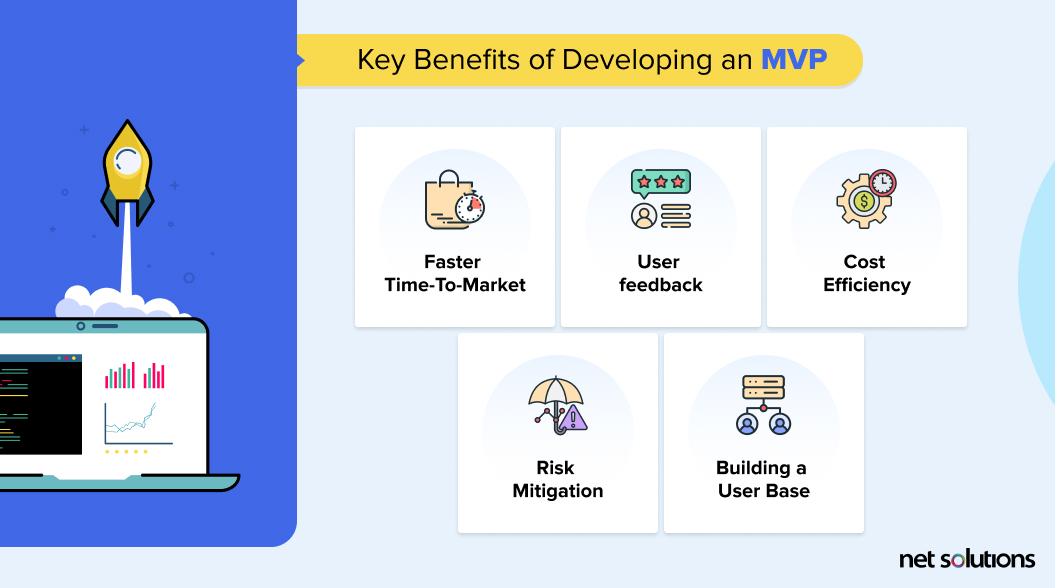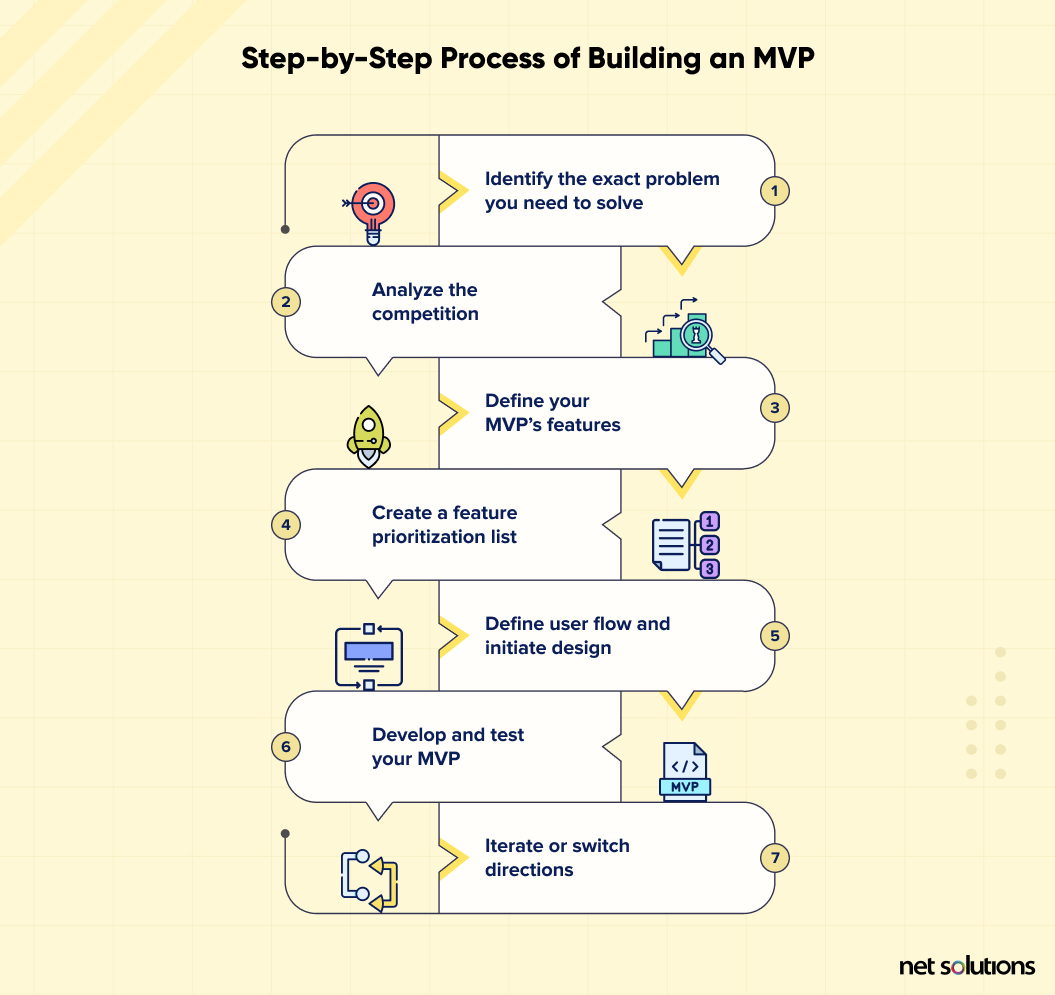The MVP approach to creating new software products is aligned perfectly with Agile development principles, which favor iteration, feedback, and collaboration to create a final product that end-users love.
The two methodologies fit seamlessly together, so we created this guide on how MVP development works with Agile frameworks. Read on to learn why MVPs are key to Agile and how Agile teams create MVPs.
What is an MVP in Agile Software Development?
In Agile software development, a Minimum Viable Product (MVP) refers to an initial release of a product that offers basic functionality. It’s designed to validate the product idea and gather user feedback that will shape future design choices.
Popularized by Eric Ries in “The Lean Startup,” the approach is rooted in the idea that you’ll create better software products for your target audience by giving real users and early adopters a say in product design.
Since Agile developers are used to approaching software development with flexibility, changing their approach based on discussions with key stakeholders, user feedback, and more, the MVP approach fits well into the Agile mindset.
How Does an MVP Fit into the Agile Development Process?
Before Agile became the most popular approach to product development, software development teams used a more rigid, top-down strategy called Waterfall. The Waterfall methodology meant that product features were largely mapped out from the beginning before a project began.
Here are some of the drawbacks of the Waterfall methodology.
- Wasteful Output: Waterfall often means using resources to create features that users don’t want or need
- Inefficient Productivity: Full-fledge software products can take months or years to produce, and features could be outdated by the time they hit the market
- Needless rigidity: Even if developers come up with new ideas as they’re building a product, implementing and changing a Waterfall roadmap is challenging if not impossible
Agile takes a radically different approach, working in quick sprints followed by discussion and analysis that favor flexibility and quick releases so teams can figure out what works.
Similarly, the MVP approach resists the temptation to build every feature from the start. Instead, it’s all about understanding the customer needs and user experience and then integrating features that address those user needs into each new product version.
What are the benefits of developing an MVP?
Popularized by Eric Ries in “The Lean Startup,” the MVP approach is rooted in the idea that you’ll create better software products for your target audience by giving real users and early adopters a say in product design.
Here are some of the key benefits associated with MVPs.

- Faster time-to-market: The best MVPs offer a solution that requires the least effort to create, bringing the initial product to market much faster than a full-fledged version.
- User feedback: MVPs allow you to gather feedback from the real world, which is essential for validating your product idea as well as identifying pain points to solve in future versions
- Cost efficiency: The MVP approach saves money because you won’t spend time creating features that nobody wants
- Risk mitigation: By validating your idea early on and engaging in iterative development, you can help ensure there’s a market for the solution you’re providing
- Building a user base: MVPs attract early adopters who form the foundation of your user base, and if you address their needs, many will become loyal fans
Read our post about the benefits of MVPs for a more in-depth analysis of each of these benefits (along with two additional benefits).
What Are Some Examples of Agile MVPs?
MVPs often take the form of a fully functional (albeit simply) software product, but not always! Here are five examples of MVPs that look a little different from what we typically imagine but still serve the goal of product validation and gathering customer feedback.
- Concierge MVP: A concierge MVP may consist of a website or a simple product that allows people to perform a given task. This task would normally be automated, but instead, you have someone behind the scenes perform the task.
- Wizard of Oz MVP: A Wizard of Oz MVP is identical to the concierge MVP, except that the Wizard of Oz MVP appears to be a working, fully automated product. Like the wizard in the famous story, you’ve created a powerful illusion.
- Landing Page: A landing page MVP is a way to generate interest in your hypothetical product by driving traffic to the page and gathering early signups for the first release. This will allow you to validate the product idea and see if your solution captures anyone’s attention.
- Email MVP: Similar to the landing page idea, an email MVP is simply an email that goes out to your target audience (who may already be your customers) to assess interest in a new product you might bring to market.
- Low-code or no-code MVP: Using low-code and no-code tech, you can bring a simple product to life that meets the bare minimum requirements needed to validate the idea.
Read more about the different types of MVPs in our post about Minimum Viable Product types.
How Do You Build an MVP Using the Agile Methodology?
Building an MVP demands the same due diligence, forethought, and market research required to produce any full-fledged software product from scratch. In other words, just because the product doesn’t have a full set of features doesn’t mean you want to approach it haphazardly.

Here’s a brief overview of the step-by-step process of building an MVP.
1. Identify the exact problem you need to solve
Brainstorm potential problems worth solving and look for areas that the current options on the market fail to address. You can generate ideas by looking at review sites for current products and interviewing members of your target audience.
2. Analyze the competition
Take a deep dive into similar products that are currently on the market. These products will be your competitors, so it’s important to identify which features you could introduce to the market that these products lack.
It can be helpful to conduct sentiment analysis on current competitors to get a broad sense of what customers say and how they feel about them. At the very least, gather your data and conduct research.
3. Define your MVP’s features
Your MVP will offer certain core features, perhaps one or two, that directly speak to a massive need and provide a solution that isn’t adequately addressed. The design doesn’t need to be perfect, but it should meet basic usability standards and solve a significant problem.
4. Create a feature prioritization list
You’ll come up with a list of potential features you can include in your first release and thereafter, and you’ll need to prioritize ones that offer a strong ROI. Consider the costs, ease of implementation, risks, and benefits of adding specific new features and prioritize them accordingly.
5. Define user flow and initiate design
One of the most important things to do in the early stages of design is to understand what the user journey will look like—where they click and what they do in your app to achieve their goals. Testing these ideas on potential users using low-fidelity prototypes will help you determine whether your product is usable and intuitive.
6. Develop and test your MVP
Using an Agile methodology, build and continually test your MVP, gathering feedback from users and key stakeholders throughout the process.
In true Agile fashion, you’ll iterate as you go, working to build an initial release that stands the greatest chance of resonating with your key audience and filling a hole in the market.
7. Iterate or switch directions
What does your first round of feedback tell you about your MVP? Does it solve the problem effectively? Look at the data and trust the metrics to avoid letting your own biases get in the way.
If the product idea proves viable, what changes can you make to make it more effective, and what new features can you add? If the market completely rejects it, can you pivot to a new approach, or should you start over from scratch? These are the questions your team will need to discuss after launch.
What Are Some Common Agile Methodology MVP Mistakes?
No MVP will ever be perfect. By its very nature, an MVP emphasizes solving major pain points rather than addressing the minutia from the start. That said, it’s important to avoid certain common mistakes to give your MVP a fighting chance.
1. Not niching down
One of the worst things you can do with any new product is to try to be all things to all people.
Your MVP should seek to solve a specific problem for a narrow enough market segment that it can gain traction within that niche. One way to ensure that you’ve properly niched down is to create user stories and know who you’re addressing.
2. Adding too many features
Remember the scope of your efforts! MVPs should include a handful of features that solve the problem you intend to solve. Trying to create too many features in the beginning defeats the purpose of building an MVP.
Adding too many features will:
- Slow down your time-to-market
- Add unnecessary costs
- Divert the attention of your users, who should be giving you feedback on your most important features
Stick to the most important features and leave it at that. You’ll have plenty of time to add new, data-driven, customer-approved features down the line.
3. Not investing in UX design
Just because you’re creating a stripped-down version doesn’t mean you should neglect the MVP User Experience (UX). It’s not about adding fancy design—that can come down the road—but you want the product to be intuitive and easy to use.
After all, if your customers can’t figure out how to use the product due to poor design, they’ll never get around to properly assessing its key functionality.
4. Postponing the launch
One point of an MVP is to move efficiently. Getting the product in front of your target audience as quickly as possible (without cutting corners) will give you rapid feedback and the opportunity to iterate.
Waiting too long to take the product to market gives your competitors the chance to swallow up that market share, and your solution could be out of date by the time you launch.
5. Ignoring the market
The point of an MVP is to solicit feedback from the market. After launching a product, it’s absolutely vital to evaluate, record, and adhere to the feedback your users provide. Ignoring the market throws away the primary benefit of the MVP model.
Take each round of feedback seriously, gathering both qualitative and quantitative data. If you fail to validate your idea through your MVP, don’t waste any time on that sunk cost. Either find a way to pivot or start a new project entirely.
On the other hand, if your idea has legs and the market shows a degree of acceptance, take that information to design and develop an even more powerful app in future versions.
Looking to Build an MVP with an Agile team?
Net Solutions is a software development outsourcing firm that has been building software products for startups as well as major enterprises for over 20 years. We’ve built successful applications for the Harvard Business Review, Xerox, and American Golf—just to name a few.
We typically employ an Agile Scrum approach to building an MVP, and we can handle every element of software creation, including user research, project management, UX and UI design, testing, maintenance, and development for future versions.
SHARE THIS POST
Table of Contents
Related Resources
- What Is an MVP App? A Guide to Building Successful Products
- A Deep Dive Into 7 Minimum Viable Product Benefits
- A Step-by-Step Guide to Build a Minimum Viable Product (MVP)
- 19-Step Minimum Viable Product (MVP) Checklist [With PDF]
- How Much Does a Minimum Viable Product (MVP) Cost? Here’s the Answer
- 10 Top MVP Development Companies [Great for Startups]
- 10 Minimum Viable Product (MVP) Examples You Should Know
- A Step-by-Step Guide on how to Master Your MVP Launch in 2025
- How to Prioritize Features for Your Minimum Viable Product (MVP)
- How to Test an MVP: 15 Proven Strategies that Work
- 20 Great MVP Tools to Help You Create & Launch Your Product
- 11 different Types of MVPs to Kickstart Your Software Project
- How to Nail MVP Design with UX Design Principles that Work
- MVP Website: Benefits, Best Practices, How to Build & More


